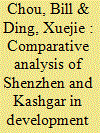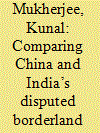|
|
|
Sort Order |
|
|
|
Items / Page
|
|
|
|
|
|
|
| Srl | Item |
| 1 |
ID:
139542


|
|
|
|
|
| Summary/Abstract |
The entry of Mongolian People’s Republic (MPR) into the United Nations (UN), from its first application in 1946, took 15 years. In the context of the global Cold War, UN membership became a tool to strengthen the influence of the USA and the Soviet Union. They supported the membership of their respective clients, while opposed it for clients of their adversary. Consequently, from 1947 to 1955, no new members joined the organization for 8 years. However, the extension of UN membership to the newly independent African countries in the mid-1950s led to a US-Soviet struggle for allies among them. In this regard, the Soviet Union succeeded in linking the package admission of the MPR and Mauritania with the issue of China’s representation. The USA, seeking to ingratiate itself to new African UN members and thus gain their collaboration on the question of China’s representation and other UN issues crucial to American interests, ultimately compromised, consenting to the MPR’s entry. In conclusion, the MPR’s admittance was the result of the struggles and compromises of the two superpowers.
|
|
|
|
|
|
|
|
|
|
|
|
|
|
|
|
| 2 |
ID:
139539


|
|
|
|
|
| Summary/Abstract |
Kashgar, a westernmost city in the restive Xinjiang Uyghur Autonomous Region bordering Central and South Asia, was paired with the southern city of Shenzhen, the most successful special economic zone for its future development. The development of Kashgar’s economy in specific and the Xinjiang in general is a part of China’s new Silk Road project which serves multi-purpose goals, such as narrowing regional disparity, reducing ethnic tensions, fighting terrorism and balancing US pivot to Asia. It is skeptical whether the Shenzhen model can be transplanted into Kashgar. The plan of developing Kashgar’s economy and establishing Kashgar special economic zone may be considered a new bottle with old wine. The development programmes in the past several decades did not address the roots of ethnic tension, including suppression of cultural autonomy and unequal distribution of the benefits and social costs of economic growth. Besides that, the success of the Shenzhen special economic zone is an exception, not a rule. It was unsuccessful in the past attempts to transfer the successful experience from Shenzhen to other special economic zones. It is skeptical whether the Shenzhen experience can be transplanted to Kashgar, whose geographical location and investment environment was much inferior.
|
|
|
|
|
|
|
|
|
|
|
|
|
|
|
|
| 3 |
ID:
139541


|
|
|
|
|
| Summary/Abstract |
The paper tries to make an assessment of the borderland regions of China and India with a focus on Xinjiang, Tibet, Kashmir and the Indian Northeast. The paper looks at the conflict in India and China's periphery, how these conflicts have evolved with time and how they have changed their character with the passage of time, from the 1950s until the present day. After looking at some background, the paper primarily focusses on three key issues which impact on all four of the conflicts: the rise of ethnic nationalism, the impact of external forces on the conflict and the human rights situation. After making an assessment of the political situation, the paper looks at the areas of similarity and differences between the four regions. Methodologically, a bottom-up approach was taken and in-depth unstructured interviews were carried out with people from the conflict zones that the paper considers.
|
|
|
|
|
|
|
|
|
|
|
|
|
|
|
|
| 4 |
ID:
139540


|
|
|
|
|
| Summary/Abstract |
Social development in Xinjiang Uyghur Autonomous Region from 1999 to 2009 is the focus of this article. I will explore the current situation among Uyghurs and Hans living in Xinjiang in different social contexts and purviews, mainly assessing problems and open questions hindering a balanced and consensus-based social development in the area. The concept of “development” per se will be understood with a critical perspective. The fieldwork was conducted in 2011 and 2012 in Urumqi, Turpan, Kahsgar, Wujiaqu and Shihezi, and in eight rural villages—seven located in the Kashgar Prefecture and one in Kizilsu Kyrgyz Autonomous Prefecture. The opportunity to adopt an “insider perspective”, at the same time working with critical tools provided by the disciplines of sociology and anthropology, can be considered an important asset in the field of Xinjiang studies. My PhD research in China (2010–2013) and my work as consultant for KFW (2011–2012) have been of great help in adopting this approach. Interviews, participant observation and analysis of quantitative and qualitative data from different sources are the basis of the fieldwork results presented here. UNDP indicators and indexes are taken as reference in setting and organising data.
|
|
|
|
|
|
|
|
|
|
|
|
|
|
|
|
| 5 |
ID:
139538


|
|
|
|
|
| Summary/Abstract |
In this article, I would like to show that China’s rough treatment of Uyghurs is related not only to domestic tensions in Xinjiang but also to the legacy of Uyghurs’ association with the Soviet Union and Russia against China’s nationality policy. Both, but particularly Moscow, used the Uyghurs in their virtual propaganda and, moreover, also in actual acts of organizing outfits—mainly civilian but also military—including espionage, sabotage, and even preparations for invasion. While most—if not all—of these attempts failed, the memories of these actions still survive. Behind the apparent friendship between China and Russia today are hidden mutual suspicions as well as unsettled accounts going back as far as the seventeenth century. Given these potential, and occasionally actual, tensions and China’s growing economic advantage over Russia, a future conflict is an eventuality that should be taken into consideration, meaning that Uyghurs may become pawns in this playground yet again.
|
|
|
|
|
|
|
|
|
|
|
|
|
|
|
|
|
|
|
|
|